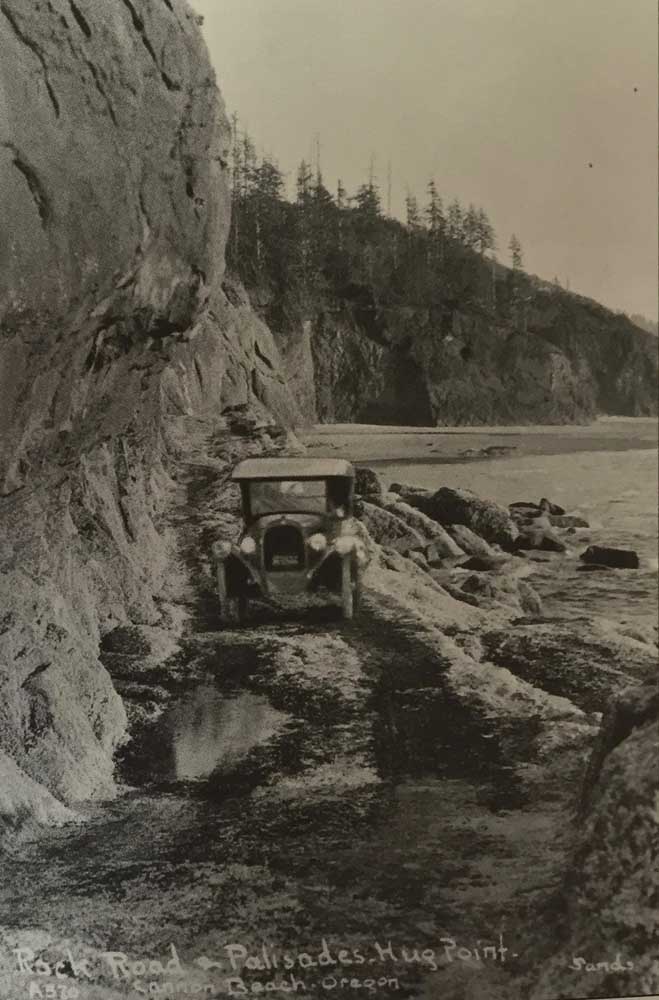Celebrating those who built the roads, dug the rock
Published 8:00 pm Tuesday, July 12, 2016

- The rocky and dangerous coast road at Hug Point was intended for traffic prior to the building of Highway 101.
Author Deb Cuyle is fascinated by the crunch of gravel and the movement of rock, the play of mountains and tides as they shaped Cannon Beach. Her history focuses less on the cultural and social life — so well documented in Peter Lindsey’s “Coming in Over the Rock” and Terence O’Donnell’s magical “Cannon Beach: A Place by the Sea” than on the men who blasted rock and dared landslides to create a postcard city with international appeal.
This entry in Arcadia Books’ Images of America series zeros in on the geography and the particular challenges Cannon Beach, Tolovana and Arch Cape faced in early days, bringing to life the hairpin turns of a logging truck coming down a steep curve and the superhuman efforts of highway department workers as they dug through mud and downpours to excavate thousands of yards of dirt building the tunnel in 1936.
“When people today drive to Cannon Beach via Highway 26 from Portland or the road from Cannon Beach to Seaside, it is hard to imagine those roads were once just muddy paths,” Cuyle said in a phone interview.
Cuyle, a former Cannon Beach resident, is the author of “Kidding Around Portland: What to Do, Where to Go, and How to Have Fun in Portland” and “Haunted Snohomish,” an Arcadia book paying tribute to the supernatural side of Snohomish, Washington, where she resides.
“This project was kind of a labor of love,” Cuyle said. “When I was going to Cannon Beach, I noticed there wasn’t a history book. So I came back and talking to Arcadia. ‘Why haven’t you done Cannon Beach, it’s the best place in the world?’ They’re like, ‘We’ve been thinking about that for 10 years.’ So again, I asked, ‘Well why hasn’t anybody done it?’”
Cuyle’s persistence paid off and after preparing a proposal earned a contract with the Images of America series. “When I lived in Cannon Beach I fell in love with it,” Cuyle said. “It is hard not to. The way the town is preserved and presented is absolutely stunning. I wanted to learn more about its history and the founding fathers who so eagerly wanted to develop the area.”
She launches her journey in 1846, when Lt. Neil Howison sailed the USS Shark into the mouth of the Columbia River. When the ship encountered trouble, Howison ordered the masts to be chopped off and the cannons pushed overboard to lighten the ship, dropping the cannons into the sea. In the 1860s, John Hobson and his business partner M. Eberman regularly spotted a cannon in a creek as they drove cattle to Tillamook. Retrieval of the weapon didn’t come until January 1898, when a mail carrier named George Luce found and retrieved the cannon from which Cannon Beach derives its name.
“Remittance men” — sons of wealthy Englishmen who came to Cannon Beach to work though still receiving money from home — comprised many of the 50 families occupying the 90-mile stretch of land between Tillamook Mountain and Neahkahnie Mountain in the late 1800s, Cuyle writes.
She presents the old days of horse-drawn carriages, summer tent camps, clearing of the land, the first hotels and automobiles.
In 1891, James P. Austin built the Austin House, which was both a hotel and a post office. More lodgings followed. The Hotel Bill was constructed in 1904, the Warren Hotel in 1911 and the Ecola Inn in 1913.
While variously called Seal Rock, Ecola Creek, Silver Point Cliffs and Brighton Beach, the Cannon Beach name became official in 1955.
Pictures bear witness to the Herculean efforts of construction teams as workers work nonstop during rainstorms in mud and falling rock. And their ingenuity. A photo of the 1936 creation of the Arch Cape tunnel shows a beached bulldozer dragged by the drums and cables of a “gas donkey,” a contraption more commonly used to pull logs from the woods.
“The more I learned about the trials and tribulations these early settlers had to endure, and the incredible amount of hard work involved, the more I realized that the area has tugged at people’s hearts since it was first discovered,” Cuyle said. “I wanted people to discover how the very important road systems and land developments for Cannon Beach were established.”
The highway from Portland to Cannon Beach, originally the Wolf Creek Highway and now the Sunset Highway, was built between 1933 and 1936 by the labor of the Civilian Conservation Corps and the Works Progress Administration in the aftermath of the Great Depression. “It would take days to get from Portland to Cannon Beach,” Cuyle said. “Now, we do it in 45 minutes with a stop at 7-Eleven.”
Cuyle hopes to bring readers “back and make them remember what it was like,” she said. Equal measure is given to the development of Arch Cape, Hug Point and Ecola State Park, with dramatic photos of a 1961 mudslide, or “earth slippage.” “I am sure the book is not perfect and was really just a labor of my love for Cannon Beach, but I do hope it will bring happiness to all who read it,” Cuyle said. “And when they are sitting with their toes in the warm sand nestled by a beach fire, I hope they will try to remember how Cannon Beach got to where it is today and some of these photographs and information will stick in their minds.”
R.J. Marx is The Daily Astorian’s South County reporter and editor of the Seaside Signal and Cannon Beach Gazette.





